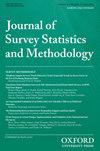伪贝叶斯小面积估计
IF 1.6
4区 数学
Q2 SOCIAL SCIENCES, MATHEMATICAL METHODS
引用次数: 0
摘要
在抽样调查中,如果一个亚群体没有足够大的样本来单独产生对某一特征的充分准确的估计,那么它就被称为“小区域”或“小领域”。在小区域估计中,来自不同亚种群的样本量往往太小,无法准确估计其平均值,因此可以通过基于相关协变量的适当模型从相似的亚种群中借鉴力量。经验最佳线性无偏预测(EBLUP)方法是小区域估计中基于频率模型的主要方法。该方法依赖于基于数据边缘分布的模型参数估计。作为该方法的替代方案,观测最佳预测(OBP)方法通过最小化由总均方预测误差隐含的目标函数来估计参数。我们在Fay-Herriot模型中使用这个目标函数来构造模型参数在接近无信息先验条件下的伪后验分布。数据分析和仿真表明,伪贝叶斯估计器(PBEs)与OBPs和eblps具有较好的竞争优势。PBE估计具有鲁棒性,不会导致错误规范,并且具有良好的频率特性。作为贝叶斯构造,它们自动避免了对标准误差的负估计,享有双重证明,并为从业者提供了一个有吸引力的替代方案。本文章由计算机程序翻译,如有差异,请以英文原文为准。
Pseudo-Bayesian Small-Area Estimation
In sample surveys, a subpopulation is referred to as a “small area” or “small domain” if it does not have a large enough sample that alone will yield an adequately accurate estimate of a characteristic. In small-area estimation, the sample size from various subpopulations is often too small to accurately estimate its mean, and so one borrows strength from similar subpopulations through an appropriate model based on relevant covariates. The empirical best linear unbiased prediction (EBLUP) method has been the dominant frequentist model-based approach in small-area estimation. This method relies on estimation of model parameters based on the marginal distribution of the data. As an alternative to this method, the observed best prediction (OBP) method estimates the parameters by minimizing an objective function that is implied by the total mean squared prediction error. We use this objective function in the Fay–Herriot model to construct a pseudo-posterior distribution for the model parameters under nearly noninformative priors for them. Data analysis and simulation show that the pseudo-Bayesian estimators (PBEs) compete favorably with the OBPs and EBLUPs. The PBE estimates are robust to mean misspecification and have good frequentist properties. Being Bayesian by construction, they automatically avoid negative estimates of standard errors, enjoy a dual justification, and provide an attractive alternative to practitioners.
求助全文
通过发布文献求助,成功后即可免费获取论文全文。
去求助
来源期刊
CiteScore
4.30
自引率
9.50%
发文量
40
期刊介绍:
The Journal of Survey Statistics and Methodology, sponsored by AAPOR and the American Statistical Association, began publishing in 2013. Its objective is to publish cutting edge scholarly articles on statistical and methodological issues for sample surveys, censuses, administrative record systems, and other related data. It aims to be the flagship journal for research on survey statistics and methodology. Topics of interest include survey sample design, statistical inference, nonresponse, measurement error, the effects of modes of data collection, paradata and responsive survey design, combining data from multiple sources, record linkage, disclosure limitation, and other issues in survey statistics and methodology. The journal publishes both theoretical and applied papers, provided the theory is motivated by an important applied problem and the applied papers report on research that contributes generalizable knowledge to the field. Review papers are also welcomed. Papers on a broad range of surveys are encouraged, including (but not limited to) surveys concerning business, economics, marketing research, social science, environment, epidemiology, biostatistics and official statistics. The journal has three sections. The Survey Statistics section presents papers on innovative sampling procedures, imputation, weighting, measures of uncertainty, small area inference, new methods of analysis, and other statistical issues related to surveys. The Survey Methodology section presents papers that focus on methodological research, including methodological experiments, methods of data collection and use of paradata. The Applications section contains papers involving innovative applications of methods and providing practical contributions and guidance, and/or significant new findings.

 求助内容:
求助内容: 应助结果提醒方式:
应助结果提醒方式:


